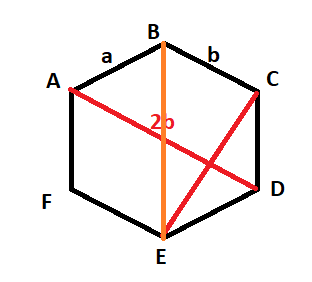Answer
384.6k+ views
Hint: This question utilises the laws of vector addition and multiple properties of vectors that need to be remembered to solve this question. We approach or begin this question by marking the vectors on a regular hexagon and solve for different sides until we get the diagonal that the question is asking for. We will need to remember the properties of the isosceles triangle that is a part of a regular hexagon.
Complete step by step solution:

In the question, two vectors have been given. They are both adjacent vectors, that is
$AB = \vec a$ and $BC = \vec b$ .
The question asks for the body diagonal that passes through B and E.
That is, $CE = ?$
We can see that $ABCD$ is part of an equilateral triangle with $AD$ as the base and $BC$ passing through the midpoints of the other two sides. This property gives the conclusion that the base is twice the length of the line passing through the midpoints of the sides.
Therefore,
$AD = 2\vec b$
Using the laws of vector addition of a polygon,
\[AD = AB + BC + CD\]
\[ \Rightarrow 2\vec b = \vec a + \vec b + CD\]
\[CD = \vec b - \vec a\]
Since $BE$ is twice the length as $CD$ and has same directions, that is parallel direction, therefore,
$BE = 2CD$
$ \Rightarrow BE = 2\vec b - 2\vec a$
Again using triangle law of vector addition,
$BE = BC + CE$
$CE = BE - BC = 2\vec b - 2\vec a - b$
$ \Rightarrow CE = \vec b - 2\vec a$
Therefore the correct option for this question is $\left( c \right)\vec b - 2\vec a$
Note:
This question has multiple ways to solve it since any amount can be solved before we get the vector we require. Many sides can all be clubbed together and many diagonals can be calculated simply to get the diagonal we need. It’s all about solving the question in as few steps as possible to make it fast and avoid any silly mistakes.
Complete step by step solution:

In the question, two vectors have been given. They are both adjacent vectors, that is
$AB = \vec a$ and $BC = \vec b$ .
The question asks for the body diagonal that passes through B and E.
That is, $CE = ?$
We can see that $ABCD$ is part of an equilateral triangle with $AD$ as the base and $BC$ passing through the midpoints of the other two sides. This property gives the conclusion that the base is twice the length of the line passing through the midpoints of the sides.
Therefore,
$AD = 2\vec b$
Using the laws of vector addition of a polygon,
\[AD = AB + BC + CD\]
\[ \Rightarrow 2\vec b = \vec a + \vec b + CD\]
\[CD = \vec b - \vec a\]
Since $BE$ is twice the length as $CD$ and has same directions, that is parallel direction, therefore,
$BE = 2CD$
$ \Rightarrow BE = 2\vec b - 2\vec a$
Again using triangle law of vector addition,
$BE = BC + CE$
$CE = BE - BC = 2\vec b - 2\vec a - b$
$ \Rightarrow CE = \vec b - 2\vec a$
Therefore the correct option for this question is $\left( c \right)\vec b - 2\vec a$
Note:
This question has multiple ways to solve it since any amount can be solved before we get the vector we require. Many sides can all be clubbed together and many diagonals can be calculated simply to get the diagonal we need. It’s all about solving the question in as few steps as possible to make it fast and avoid any silly mistakes.
Recently Updated Pages
How many sigma and pi bonds are present in HCequiv class 11 chemistry CBSE

Why Are Noble Gases NonReactive class 11 chemistry CBSE

Let X and Y be the sets of all positive divisors of class 11 maths CBSE

Let x and y be 2 real numbers which satisfy the equations class 11 maths CBSE

Let x 4log 2sqrt 9k 1 + 7 and y dfrac132log 2sqrt5 class 11 maths CBSE

Let x22ax+b20 and x22bx+a20 be two equations Then the class 11 maths CBSE

Trending doubts
Fill the blanks with the suitable prepositions 1 The class 9 english CBSE

At which age domestication of animals started A Neolithic class 11 social science CBSE

Which are the Top 10 Largest Countries of the World?

Give 10 examples for herbs , shrubs , climbers , creepers

Difference between Prokaryotic cell and Eukaryotic class 11 biology CBSE

Difference Between Plant Cell and Animal Cell

Write a letter to the principal requesting him to grant class 10 english CBSE

Change the following sentences into negative and interrogative class 10 english CBSE

Fill in the blanks A 1 lakh ten thousand B 1 million class 9 maths CBSE



